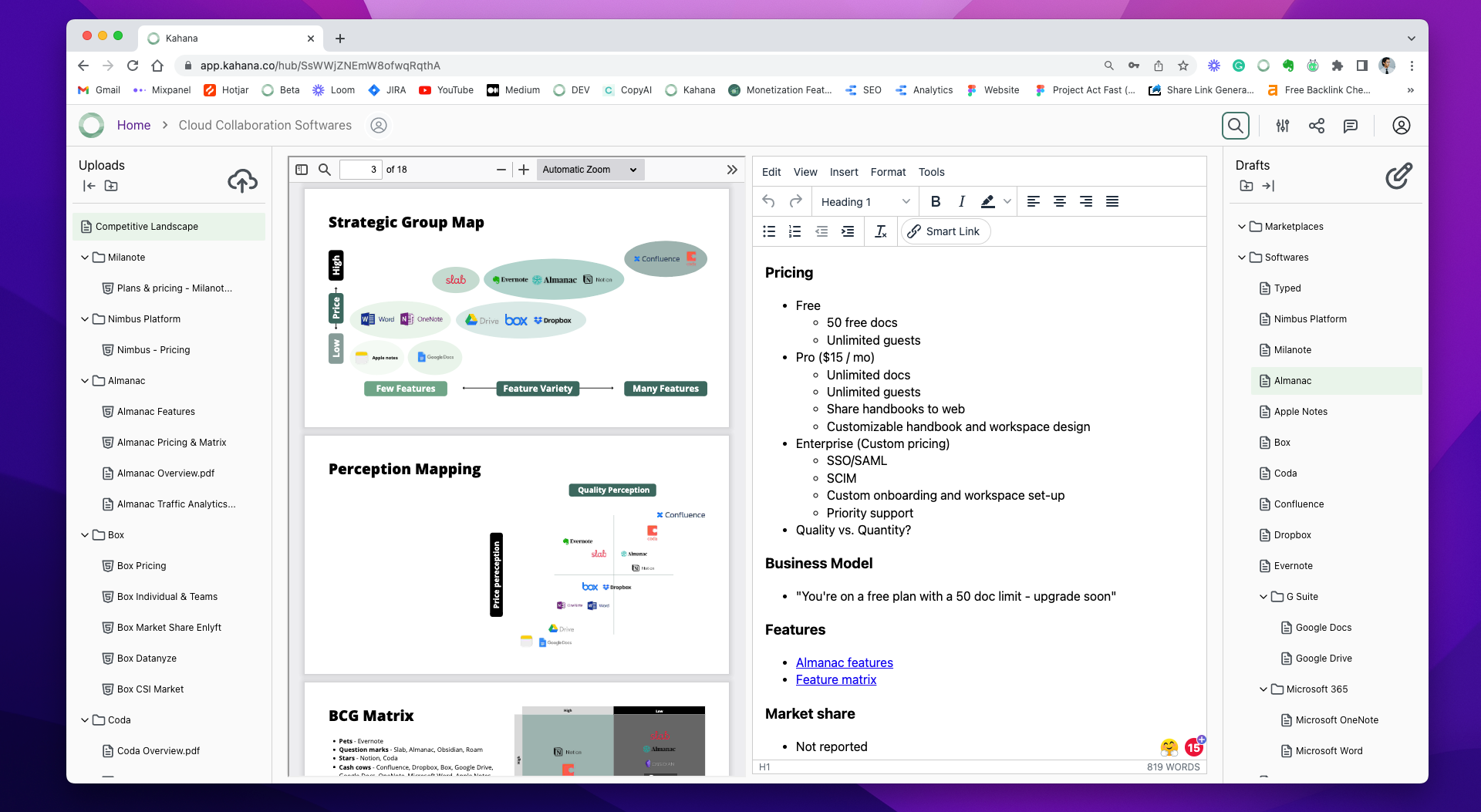Market Panel Research: Types, Methods, Advantages [template]

Topics covered ✅
- Panel research example
- Market research panel companies
- B2B market research panels
- Online research panels
- Research panelist
If you would like to learn more about market panel research, you've come to the right place.
This article provides an in-depth explanation of what market panel research is and how it works.
Panel research is a necessary concept to understand if you would like to be able to complete market research in an efficient, cost-effective way.
1. Market Research Panels
Market research panels are groups of recruited people who have agreed to participate in various types of market research studies.
These market research studies consist of interviews, surveys, and other data collection techniques, depending on what the goal of the research is.
- Participants in a particular group generally share some sort of common characteristic with one another.
- Participants may also participate in the panel for an extended period of time, continuing to have data collected on them until the panel expires.
The overall goal of a market research panel is to learn more information about the customer experience.
Understanding customers’ needs helps to guide companies when it comes to making necessary changes to their products and advertisements.
Market research panels are one of the best ways to gather information on target audiences, and how those audiences perceive certain products.

Claim My Free Market Research Template
This hub serves as a ready-made model filled with examples, PDFs, and tools to help you improve your market research.
2. Types
There are two main types of market research panels you need to be aware of:
Research Supplier Panels
A market research supplier panel is carried out at the supplier level. It deals with a combination of target markets, including B2B (business to business) and B2C (business to consumer).
An example of this type of panel would be one conducted by the supplier of Bounty paper towels.
The supplier would either use the panel to gather intelligence for Bounty on their competitors or to gather information pertaining to the supply chain.
Corporate Panels
A market research corporate panel is made up of customers or potential customers who use a specific product or service.
This type of panel is typically smaller, and there are often multiple traits that panel members have in common.
Keeping in line with the Bounty example, a group of stay-at-home mothers who regularly use Bounty as a cleaning product would be labeled as a corporate panel.
Aside from these two main types of panels, it's also important to distinguish between B2B and B2C panels themselves.
B2B panels are composed of business owners and industry professionals, while B2C panels are composed of consumers that use the product that is being researched.
Whether a panel is a B2B, B2C, corporate, or supplier panel depends on the product type or service a company provides.
3. Decision
The decision to use a market research panel is an important one and knowing the advantages of using one can help make that decision easier.
List of advantages
- Speed - Market research panels provide results quickly. Because market research panels are often carried out online, data can be gleaned from participants very efficiently.
- Quality - Market research panels can easily harness multimedia elements. They can use videos, audio clips, pictures, and text to inform their participants. These types of media can be woven together in a way that is easily understood by panel members, making the feedback even stronger.
- Savings - Market research panels are a cost-effective way to test an idea with a target audience. Rather than collaborating with the public, market research panels provide companies with a way to collaborate with a specific group of individuals from a target market. Companies can then apply what they've learned from their research panels to the greater population.
4. Online Panels
Online panels are the most affordable and accessible type of research panel.
They can also be as effective as working with an in-person panel.
Online research panels allow for multiple different facets of research.
For starters, they can provide valuable insights on frequency.
Panels may partake in longitudinal research, where companies track public opinions or customer experiences over time.
By surveying participants multiple times over an extended period, researchers can easily track how behavior and perception shift.
In addition, online panels are helpful when researching resources.
Before launching a product, it's necessary to conduct product testing market research.
This allows companies to know how many resources they'll need when they scale up their business, or if it's even possible to scale up at all.
Similar to how online panels are useful in researching resources, they can also help carry out concept testing.
Companies may have a decent idea for a product, but online panels can make that idea better.
By providing valuable information on how a product should be tweaked, products can be made more appealing to certain target markets.
5. Online Market
Defining which market you want to explore is another important step in creating an effective market research panel.
While limiting yourself to an online panel may exclude some people from your results (ex. those without the internet or who chose to go without a computer), most of the world is generally online these days.
There are two different ways to reach out to a target market online: you-find-them and they-find-you.
You-find-them Approach
For a you-find-them approach, companies will post advertisements on message boards.
These messages usually state that people with X characteristics are needed to participate in an online research panel.
Sometimes researchers may provide a reward for participation.
These rewards can include gift cards or cash.
For panels that need participants with extremely specific characteristics, companies may need to attach a higher compensation price to their advertisements.
Higher compensation makes it more likely to gain the interest of people who fit the panel’s requirements.
They-find-you Approach
For a they-find-you approach, companies will put out surveys and questionnaires online, asking participants to fill out their demographic information first.
Once this step of the survey is completed, the answers participants give help filter them into their respective target groups.
While this type of data collection can provide a lot of information quickly, there are a couple of drawbacks.
For one, you cannot guarantee certain target audiences will be reached this way.
Another issue is after data collection is complete, extra sorting will be necessary to filter out any insufficient responses.
6. Target
As mentioned before, when dealing with markets, you must set your sights on a target audience.
Investing time into segmentation research and audience research tools can help you refine your marketing strategy for your product.
Target market analysis surveys are tools used by market researchers to help determine a client's target market.
It can be beneficial for companies to take these surveys themselves as well, to get a better understanding of their own goals.
Types of questions often found in these surveys include “Is your target market composed of individuals, companies, or both?” and “What percent of your target market would you estimate is taken up by your competitors?”
7. Sample
The group of participants in an online market research panel is just a small sample of the actual target market of a company.
Members have to share a lot of their personal information with researchers to ensure they are qualified to participate on the panel.
Types of questions participants might be asked include demographic, household, and behavioral questions.
Demographic questions
This can include questions about a person’s age, race, ethnicity, level of education, sex, and gender.
Household questions
This can include questions about household size, amount of income, number of children, and marital status.
Behavioral questions
This can include questions about political views, consumption habits, hobbies, and exercise habits.
Researchers may ask for more information than actually needed for the panel they're conducting.
Doing so allows researchers to create a database of personnel they can go back to if they should need to host another research panel based on a separate set of criteria.
8. Experience
The market research panel process has 5 key steps.
Step 1: Set a goal
- What do you want to figure out?
- What are you trying to accomplish?
The first step in any online market research panel is to outline a goal for your research by creating market research questions to be answered.
Step 2: Determine your panel size
When determining the size of your panel, you must consider what type of responses you'll be gathering.
- Will you try to recruit panel members first and have a set group of individuals answering all of your research questions?
- Or will you blast surveys out online and aim to receive a certain number of responses?
If you wish to do the latter option, you must consider what response rates typically are and the total number of studies you would like to conduct.
You may need to send surveys to more people than you think will answer them.
Something else to consider is the establishment of quotas, to ensure you do not receive too many responses.
If you outsource your online research panel to another company, they'll charge you for every response you get.
Quotas help ensure surveys will be withdrawn once your set number of responses has been hit.
Step 3: Program your survey
You'll need to brainstorm the questions you plan to ask panel participants when they encounter your survey.
You may choose to work through a company online that specializes in research panels and surveys, but they still must be informed on what data you're trying to collect.
Step 4: Recruit your panel
Working online means there are a variety of ways you can reach potential and current customers for panel participation.
When reaching out to existing customers, utilizing your customer email database can be handy.
Other avenues of outreach include social media, your company website, or through online advertisements.
Step 5: Soft launch followed by a hard launch
Before releasing your survey to the masses, it's a good idea to perform a soft launch.
By practicing this method, you can verify each question is being interpreted correctly.
This also helps make sure the data being collected accurately represents the responses, by giving a few individuals the survey before your entire sample of participants completes it.
After the soft launch, once necessary changes are made, your survey can be hard launched.
A hard launch means your online market research panel can go into full effect and everyone you are trying to sample will have access to the finalized survey.
9. Answers
Once you've received the full number of responses desired for your panel, the last step is to clean the data.
Cleaning the data means sorting out any responses that were counted, but are not actually valid.
Examples of response types to omit
Below is a list of response types many research panels receive, but do not use.
- Speeding - when respondents clearly answered questions too quickly and without thought.
- Flat-lining - when respondents choose the same answer for several questions because they wanted to get the survey over with.
- Duplicates - when respondents fill out the survey multiple times, leading to duplicate responses.
Finally, once the data has been cleaned, market researchers will be able to draw conclusions from their online panels.
These conclusions shape marketing strategies and product development going forward. This process can be repeated as many times as needed, with different goals and survey questions.
10. Survey
Survey questions that are asked will vary based on the goal of each individual research panel.
The length of surveys will vary, too.
Generally, a 10-question survey is a good starting point.
You don't want your surveys to be too short, where you won't get enough information out of the participants.
On the other hand, if surveys are too long, participants will lose interest or fall victim to speeding or flat-lining.
To give you a better idea of a more specialized type of survey with a unique set of goals, one example is a package label test survey.
This type of survey is created to allow an organization to explore the opinions of customers on different packaging label designs.
A package testing survey template may include questions about first impressions of packaging, packaging appeal, packaging readability, packaging word associations, and overall preference.
Ultimately, survey questions are up to the researchers.
With that being said, we will leave you with some advice on creating surveys and market research panels in general.
Advice
First off, asking good questions leads to clearer results from research panels.
The best research questions are created by researchers who fully understand what type of data they wish to collect.
This relates to the most important thing to remember; research panels take time.
The more time you invest in brainstorming research questions, determining how you will collect data, and figuring out what type of answers you are looking for, the better your research will be.

Talk with a Kahana representative
Fill out your information and a Kahana team representative will reach out to you. Have a simple question? Search our library of articles
